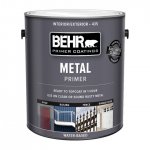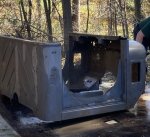For Diverman-The 24087 is a single color. It is the Korean War/Vietnam era semi-gloss olive drab and was used as a solid color vs. a camo pattern. The colors used on the MV's differ depending on what era you want to depict on your truck. Since you said you wanted a "pattern" I assume you want a camo pattern. You should be able to find your truck in the TM-
http://www.steelsoldiers.com/upload/M35/TB43-0209.pdf
This manual has all the trucks and equipment colors in Paint-by-number line drawings. I just painted my M109A3 and it was pretty simple. I used phosphoric acid to neutralize the rusted areas on the truck, scraped/sanded and then painted the rusted areas and all the seams with Rusteoleum rusty metal primer. I let the primer cure for 2 weeks and then painted it green. I made copies of the drawings in the manual and shaded them in to represent the actual colors rather than looking for all the #3's etc. Looking at the copies I used a sharpie to draw the camo pattern for the black and brown, on the truck and used the paint sprayer to paint just over the sharpie lines with the black paint. I did the brown last because it is a minor component of the scheme. The camo pattern is like the easiest paint job you will ever do, because if you mess up, you can come back from the other direction with the other color, instead of having to shoot a whole panel and get it to blend. As far as using a paint gun, there are typically 2 adjustments to make on a conventional gun-air and material. The air you use to adjust the "fan" or spray pattern (by regulating the air pressure) and the material you use to adjust the amount of material in the mix. If you are using a conventional gun, you need to make sure that the air compressor you are using will supply enough air so that you don't have to wait for the compressor to build up pressure while you are spraying (that would give you an inconsistent spray pattern). Something else you will have to play with is the paint viscosity. Typically you will have to thin paint to use in a conventional gun. Try not to exceed the paint mfg. recommendations. If you are getting big splatters, you probably need to up the air pressure or thin the paint. If you are getting runs, you are either moving too slow (putting it on too thick) or you have thinned your paint too much. Once you have your gun loaded with paint, look down at the spray pattern from above and from the side while you give the trigger a short burst to get an idea of the fan your gun is creating. You'll want to overlap your passes probably by 1/3 to get and even layer. Practice on some scrap material. several thin layers are better than thick ones. There is more, but those are the basics. Good luck.




